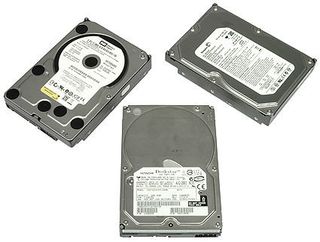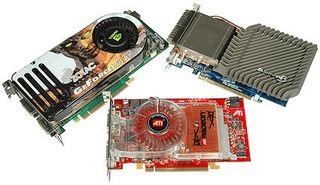Is Your PC Ready for a System Update?
Hard Drive

Our two-year old reference system runs on a 250 GB Hitachi Deskstar 7K250 hard drive.
Whether or not you can live with 250 GB remains your decision, but going for a new hard drive sometimes makes sense even if you don't need more storage capacity. Newer hard drives typically provide higher data transfer rates than older drives, and many models are quieter and stay cooler. Drives between 320 GB and 500 GB are fairly affordable these days, costing anywhere between $70 and $130. Higher capacities of 750 GB and 1 TB are available as well, but these come at quite a premium.
A new hard drive should always use the Serial ATA interface. Whether it's SATA/150 or SATA/300 isn't important in practical terms, but upcoming chipsets will no longer support UltraATA interfaces. We also recommend against buying drives below 320 GB, because the price differences are extremely small, and a 400 GB or 500 GB drive will serve you for much longer.
Graphics Card

A Radeon X850 card still can be considered nice, because it continues to offer acceptable performance. However, this product generation does not support DirectX 9.0c with Shader Model 2 and HDR support. True gamers will want a new graphics card, not only because the current AMD/ATI Radeon HD 2000 series, as well as Nvidia's GeForce 8 family, are DirectX 10 compliant, but also because even a simple mainstream card such as the GeForce 8600 can outperform the two-year old Radeon X850.
Mainstream graphics cards such as the Radeon HD 2600 or GeForce 8600 are fairly affordable and decently powerful. You might wonder if it wouldn't make sense to go for a high-end model, which is why we also included a GeForce 8800 GTS in our benchmarks. It does give you better performance, but at the cost of an additional $100. Eventually, we don't recommend running a high-end graphics card in an average system, as the CPU has become a bottleneck for many high-end graphics cards.
Let's Do It! Reviving The Two-Year Old PC
Please have a look at the system description above, or the test setup table on the following page, for information on the reference system that we used for this upgrade project. One factor that we did not consider is the main memory, as the system runs on 1 GB of DDR400 RAM. Although we always recommend 2 GB of RAM for desktop PCs today, the upgrade from 1 GB to 2 GB of RAM may or may not make sense. If you don't multitask a lot and if you don't run many applications that are resource-hungry, you will get along alright with a total main memory size of 1 GB using Windows XP.
Two reasons for leaving RAM out of the equation are the simplicity of the upgrade, as it can be done within a few minutes, and the fact that two 512 MB DIMMs start at $50, making them the cheapest item on our upgrade list.
Stay on the Cutting Edge
Join the experts who read Tom's Hardware for the inside track on enthusiast PC tech news — and have for over 25 years. We'll send breaking news and in-depth reviews of CPUs, GPUs, AI, maker hardware and more straight to your inbox.
Most Popular

